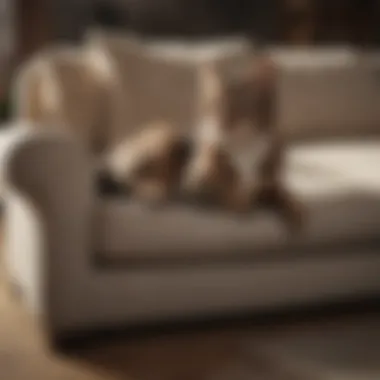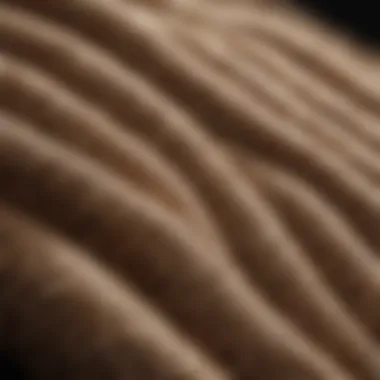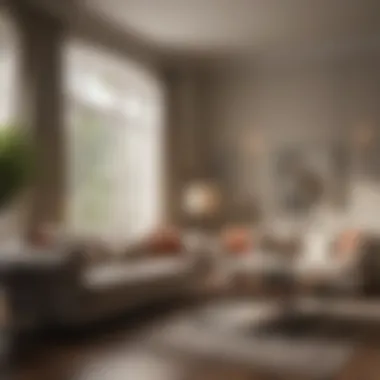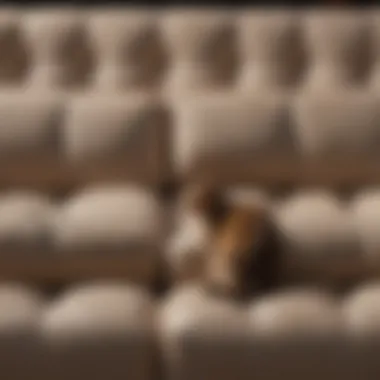Durable Sofa Fabrics for Cat Owners


Intro
In homes where cats are beloved companions, the choice of sofa fabric becomes an important consideration. Cats, by nature, have claws that can cause damage to furniture, leading many pet owners to seek solutions that offer both durability and aesthetic appeal. With the right fabric, a stylish living space can coexist with the realities of pet ownership. This guide aims to provide pet owners with a comprehensive understanding of sofa fabrics that resist claw damage, thus achieving the balance between functionality and design.
We will explore different fabric options, their maintenance needs, and how they align with various interior styles. Each section will unpack critical features, offering insightful comparisons and recommendations tailored for discerning cat owners. By the end of this article, readers will be well-equipped to make educated decisions when selecting sofa fabrics that can withstand cat claws while preserving the warmth and beauty of their home environment.
Prolusion to Sofa Fabrics and Pets
Choosing the right sofa fabric is essential for pet owners, especially those with cats. Feline behaviors can jeopardize the integrity of your furniture. When you invest in a sofa, you expect durability and style. However, living with a cat often turns that expectation into a challenge. The purpose of this section is to provide an understanding of the interaction between cat behaviors and materials commonly used in sofas. This knowledge is crucial for selecting fabrics that can withstand frequent clawing and scratching while maintaining an aesthetically pleasing design in your home.
Impact of Cat Behavior on Furniture
Cats naturally have a tendency to scratch. This behavior serves multiple purposes: marking territory, maintaining their claws, and stretching. Unfortunately, this instinct can result in noticeable damage to furniture, especially sofas.
Soft fabrics like cotton or velvet suffer significantly under the pressure of sharp claws. Scratches, pulls, or even complete tears can occur in a matter of days. Furthermore, if scratching is not properly addressed, it may lead to others forms of damage, including stains from dirt and oils transferred from the paws.
As a cat owner, it’s crucial to recognize that certain materials are more susceptible to wear and tear than others when engaged in the natural behaviors of your pet. Comprehending these dynamics helps create a living space that meets the needs of both the human and the feline residents.
The Need for Durable Materials
Durability in sofa fabrics becomes paramount when accommodating cats. Selecting the right material can significantly reduce wear and tear. Not only does a durable fabric prolong the life of your sofa, but it also leads to cost savings over time.
Fabrics with high abrasion resistance can help mitigate damage. Sofas made from synthetic fabrics, high-quality leather, or tightly woven materials are often preferred by pet owners. They can withstand the daily engagement of a playful cat without showing immediate signs of damage. Furthermore, durability often correlates with ease of cleaning, an important consideration for households with pets.
Choosing the correct fabric is more than just about endurance. It also ties back to aesthetics and comfort. Therefore, understanding the blend of durability and visual appeal is crucial for any cat owner wanting a functional yet stylish living space.
"Selecting the right sofa fabric is about harmonizing the needs of your pets with the design of your home."
By acknowledging the behaviors of cats and placing emphasis on durable materials, cat owners can ensure their furniture is as resilient as possible while maintaining the attractive qualities that sofas offer.
Evaluating Sofa Fabric Durability
When selecting a sofa fabric in a household with cats, evaluating durability is paramount. The potential for claw damage means that not all materials will hold up equally over time. Durability encompasses various aspects, including the weave of the fabric, its composition, and its resistance to wear and tear. For pet owners, understanding these elements can lead to better choices that balance both aesthetic appeal and practical needs. Choosing the right fabric not only extends the life of the sofa but also contributes to a more harmonious living environment where style meets functionality.
Understanding Fabric Weave
Fabric weave plays a crucial role in the durability of a sofa. The way fibers interlink directly impacts how well the material can tolerate scratching and biting. Common weaves include woven, knitted, and tufted fabrics.
- Woven fabrics, such as canvas or denim, boast tight interlacing, which creates a robust texture. This tight structure is a defensive barrier against claws and is less likely to snag or tear.
- Knitted fabrics tend to be more elastic, allowing for more give under pressure but may not withstand sharp claws as effectively as woven varieties.
- Tufted fabrics often feature a more luxurious appearance but can suffer from wear more readily if not constructed from durable materials.
Understanding these types helps in selecting the options that align with the expected behavior of cats. A dense weave can provide better protection against claws, rendering woven fabrics a favorable choice for cat owners.


Abrasion Resistance Ratings
Abrasion resistance is another critical factor to consider when analyzing sofa fabric durability. It measures the material's ability to withstand wear caused by friction. Fabric manufacturers usually conduct tests to determine how many times a fabric can be scuffed before it begins to show signs of wear. This rating often falls on the Martindale scale, where higher numbers indicate stronger resistance.
In practical terms, if a fabric boasts an abrasion resistance rating of 30,000 or more, it is typically suited for pet-friendly households because it can endure significant contact without damage. Some fabrics that excel in this area include:
- Microfiber: Typically has a high rating owing to its dense fiber structure.
- Leather: Offers natural resistance but can scratch; proper treatment enhances its longevity.
- Synthetic blends: Often show impressive abrasion resistance due to their engineered properties.
Sofa Fabric Options for Cat Owners
Choosing the right sofa fabric is significant for cat owners. Cats, by their nature, engage in behaviors that can be damaging to furniture. Having a selection of durable and appropriate fabrics can not only enhance the longevity of your sofa but also create a comfortable and attractive living space. In this section, various sofa fabric options are examined, weighing the pros and cons of each type. The focus is on how each option can withstand the claws of feline companions while maintaining aesthetic appeal.
Microfiber: The Pet-Friendly Choice
Microfiber stands out as an excellent choice for cat owners. Its dense weave creates a durable barrier that resists claws. Microfiber is often easier to clean compared to other materials. Small spills can be wiped away without lasting stains. Additionally, many manufacturers treat microfiber to enhance its stain resistance. This feature is crucial for households with pets, where accidents can happen. Beyond its practicality, microfiber is available in various colors and textures. This versatility allows pet owners to select options that match their decor.
Leather: Pros and Cons
Leather offers a unique blend of luxury and durability. On one hand, it can resist scratches better than most fabrics, given its tougher surface. A well-maintained leather sofa can last many years and may develop a charming patina over time. However, leather is not without its disadvantages. It can be more difficult to clean if a cat scratches the surface. Additionally, areas where claws have scored can become visible. This means careful upkeep is necessary to keep leather looking its best. For some, the aesthetic appeal may outweigh the challenges of maintenance.
Canvas: For the Pragmatic Owner
Canvas is a functional option for those seeking durability. This fabric is typically tougher, making it less vulnerable to punctures and scratches. It is also relatively easy to clean, as most canvas fibers are machine washable. Furthermore, canvas comes in a variety of colors and prints, providing both style and utility. However, its rigidity may not be as comfortable as softer options. Owners should consider their preferences for comfort versus durability when choosing canvas for their sofa.
Synthetic Fabrics: Testing the Waters
Synthetic fabrics include a range of materials like polyester and nylon. They are known for their high abrasion resistance, which can be beneficial in households with active cats. These fabrics often come with added features like stain resistance, aligning with the practical needs of pet owners. Synthetic blends can mimic the look and feel of natural fabrics while providing more durability. However, they may not breathe as well, potentially leading to discomfort in warmer conditions. As with all options, understanding the specific properties and care difficulties is essential when selecting synthetic fabrics.
Natural Fabrics: Evaluating Feasibility
Natural fabrics can offer a unique blend of comfort and aesthetics that many pet owners find appealing. However, when it comes to cats and their proclivity for scratching, these fabrics present specific challenges. Understanding the feasibility of using natural fabrics like cotton and wool requires an examination of their properties and how they align with the needs of a cat owner. In this section, we will assess the benefits and shortcomings of these fabrics in the context of durability, maintenance, and overall performance in a pet-friendly home.
Cotton: Comfortable but Vulnerable
Cotton is well-known for its softness and breathability. Owing to these properties, it is often a favored fabric for home furnishings.
- Comfort: It provides a cozy and inviting feel, making it suitable for lounging.
- Maintenance: Cotton is usually machine washable, which is beneficial for removing stains caused by pets.
- Durability: While cotton can tolerate some wear, it does present vulnerabilities. Cats' claws can easily snag and pull threads, resulting in unsightly damage.
- Stain Resistance: Cotton does not inherently repel stains, meaning spills can easily become permanent if not promptly treated.
"While cotton offers comfort, its susceptibility to damage and staining should not be overlooked by cat owners."
Wool: A Double-Edged Sword
Wool presents a complex profile for pet owners. It has its advantages and disadvantages when considering cat-related wear and tear.


- Natural Resilience: Wool fibers have natural elasticity, which can resist some degree of pulling or snagging from cat claws.
- Thermal Properties: Wool keeps a warm environment, which can be particularly pleasant for both pets and humans.
- Stain Resistance: Unlike cotton, wool has some natural resistance to stains and dirt. This quality can make it easier to maintain against common pet accidents.
- Potential for Damage: Despite its robustness, wool can still fall victim to aggressive scratching. If a cat is particularly persistent, it can lead to pilling or tearing.
- Odor Retainment: Another consideration is that wool can trap odors more readily, which may not be preferred in a multi-pet household.
In summary, while natural fabrics like cotton and wool can enhance the home environment, their suitability as sofa coverings in cat-friendly spaces requires careful thought. Cat owners should weigh the comfort benefits against the potential for damage and maintenance challenges.
Understanding Maintenance Needs
When selecting sofa fabrics suitable for homes with cats, maintenance is a crucial factor. Cat owners often face unique challenges due to the playful and sometimes destructive nature of their pets. Choosing a fabric that is easy to maintain can save time and effort. Regular cleaning routines can help prolong the life of the sofa, keeping it looking fresh and new. Moreover, understanding maintenance needs can inform decisions on fabric selection, making sure the fabric chosen can withstand everyday wear and tear while being easy to care for.
There are several specific elements to consider in this context:
- Ease of Cleaning: Different materials require different cleaning methods. For instance, some fabrics can be spot cleaned easily, while others might need professional cleaning. Considering the cleaning requirements can help avoid future frustration.
- Time Investment: Some fabrics demand more time and effort to keep them looking their best. Busy pet owners may want to prioritize fabrics that require less maintenance.
- Cost Considerations: Maintenance impacts cost over time. A fabric that seems inexpensive at first may incur high upkeep costs, which can outweigh initial savings.
Being informed about maintenance needs not only assists in choosing the right fabric but also contributes to overall satisfaction with the purchase.
Cleaning Procedures for Different Materials
Each type of fabric has its own cleaning requirements. Understanding these procedures is vital for maintaining the sofa's appearance and longevity:
- Microfiber: This fabric is known for its easy care. Routine vacuuming can remove hair and debris. Stains can often be treated with a damp cloth or specific cleaners without too much effort.
- Leather: Leather requires special care. Routine dusting and occasional conditioning can enhance its durability. If a stain occurs, it should be wiped immediately with a soft cloth to avoid absorption.
- Canvas: This material can typically be machine washed in cold water. Spot cleaning is also effective for minor stains. However, ensure it is air-dried to prevent shrinkage.
- Synthetic Fabrics: Many synthetic options have surface treatments that repel dirt and stains, making them easier to clean. Regular vacuuming combined with periodic deep cleaning can help maintain their appearance.
Stain Resistance Features
Stain resistance is an essential feature for fabrics in homes with cats. Pets can be unpredictable, and accidents do happen. Several specifics about stain resistance should be considered:
- Fabric Treatments: Some fabrics come with stain-resistant treatments. These can help prevent spills from setting in and make routine cleaning more manageable.
- Material Composition: Fabrics like microfiber or specially treated synthetic ones tend to be more resistant to stains compared to natural fibers like cotton or wool. Knowing the composition can guide your choice.
- Type of Stains: Consider what kinds of stains are most likely in your household. For example, food stains may be more relevant for families with children, while muddy paw prints are more critical for pet owners. Targeted stain protection based on specific risks can be beneficial.
Aesthetic Considerations in Fabric Selection
When choosing a sofa fabric for a home with cats, aesthetics play a crucial role alongside practicality. Owners often prioritize a fabric that not only withstands the wear and tear from claws but also complements their interior design. Understanding how to harmonize design with functionality is essential for creating a comfortable and stylish space that accommodates both pets and people.
Harmonizing Design and Functionality
It is vital to select a sofa fabric that aligns with your visual preferences while also being durable. The right fabric should enhance the surrounding decor and contribute to the overall ambiance of the room. Here are several factors to consider:
- Color Coordination: Opt for colors that match your existing color scheme. Neutral tones may hide imperfections better, while bold colors can add a statement.
- Pattern Choices: Patterns can effectively disguise scratches and fur. Fabrics with intricate designs can distract from any signs of wear that might arise due to cat activity.
- Fabric Texture: Choosing a texture that feels inviting yet resilient is key. Consider how different surfaces will wear over time and their impact on your home's aesthetics.
A successful combination of beauty and toughness will ultimately lead to a refined living space that respects the needs of both cats and their owners.
Color and Texture Choices
Color and texture profoundly impact a room's aesthetics. When selecting sofa fabric, consider the following:
- Color: Darker colors often show less dirt and fur, making them practical for cat owners. Light colors can brighten a space but may require more maintenance.
- Texture: Smooth fabrics may be less prone to snagging but could show wear more quickly. Conversely, textured fabrics can hide scratches effectively while providing a cozy feel.


These elements should be considered together rather than in isolation. A beautiful sofa should not only be a focal point but should also endure the demands of an active household.
"A well-chosen fabric can transcend mere functionality, becoming a key component of your home's style and comfort."
Real-Life Applications and Case Studies
Understanding the practical implications of sofa fabrics in the context of cat ownership is vital. By examining real-life applications and case studies, this section clarifies how different fabrics perform in households occupied by cats. These insights offer tangible value to cat owners who wish to balance durability with aesthetic appeal. When interacting with multi-pet environments, the real-world assessment of fabric options can provide essential guidance for informed decision-making.
Interviews with Cat Owners
Gathering subjective experiences from cat owners reveals invaluable perspectives on choosing the right sofa fabric. In various informal interviews, several cat owners shared their journeys navigating this tricky landscape.
One pet owner explained how microfiber allowed for easy cleanups. "My cat loves to play, and sometimes that involves accidents on the furniture. Microfiber is simple to wipe down, and it lasts longer than I expected."
Conversely, another individual chose leather. They praised its resistance to scratches and its general durability, stating, "Even though my cat climbs on it, the occasional scratch blends in, and I’ve found it relatively easy to maintain."
Through these anecdotes, it is clear that individual lifestyle choices and preferences result in varied fabric outcomes. Some cat owners preferred the comfort of soft materials, while others valued durability above all. This diversity emphasizes the importance of personal experience when choosing suitable sofa fabrics for pet owners.
Fabric Trials: Successes and Failures
Observing various fabric options in real-world settings highlights both successful and unsuccessful outcomes. These fabric trials often uncover deeper insights into the functionality of different materials.
Microfiber consistently ranks high in terms of pet-friendliness. Its tightly woven fibers resist both claws and stains. Yet, some owners pointed out that if not maintained properly, it could attract lint and pet hair.
On the other hand, canvas fabrics, while robust, did not perform as well in all cases. Some users reported that their cats’ claws could still puncture the fabric over time. In practice, they found that although canvas is easy to wash, its longevity fell short when met with persistent scratching.
The contrast between various fabrics indicates that no fabric is universally perfect. Each option has its unique strengths and weaknesses.
Culmination and Recommendations
Selecting the right sofa fabric when sharing a home with cats is a pivotal decision. This article aimed to guide readers through a thoughtful exploration of various fabrics that withstand the challenges posed by feline claws. Balancing durability, maintenance, and aesthetic appeal becomes crucial not only for preserving your furniture but also for creating a welcoming environment.
Understanding the specific characteristics of fabrics directly impacts your long-term satisfaction. Some materials, like microfiber, offer a great combination of toughness and easy care, while others, such as natural fibers, can present difficulties despite their appearance. Knowing the key factors of each option allows pet owners to navigate their choices effectively.
Summarizing Key Findings
Through our discussion, several key points emerge. First, the awareness of fabric durability is essential. The analysis of fabric weaves and abrasion resistance ratings helps in discerning how well a material will hold against potential hazards from cat claws. It was noted that microfibers and synthetic options are consistently favored for their resilience, whereas natural materials may not perform as admirably.
Additionally, maintenance practices cannot be overlooked. Easy cleaning and stain resistance are invaluable traits that contribute to the longevity of your furniture. Many users reported a preference for fabrics that allow quick and simple cleaning without sacrificing overall look.
Lastly, the integration of aesthetics with functionality is paramount. Choosing colors and textures that match your home’s decor yet stand up to clawing is a complex task requiring careful thought.
Making an Informed Choice
When deciding on the best fabric for your sofa, consider several factors. First, evaluate your cat’s behavior patterns. If your feline is particularly playful or destructive, prioritizing highly durable materials is wise. Additionally, invest time in understanding the inherent properties of various fabrics.
Keep in mind maintenance needs. Fabrics that resist stains and can be wiped clean should top your list. Finally, choose a fabric that aligns with your personal style preferences. The ultimate goal is to find a balance between aesthetics and durability, ensuring you create a pleasant space for both you and your pet.
In summary, an informed choice combines understanding the functionality of each fabric with a desire for an attractive living space. The harmonious blend of these elements will lead to a more satisfying and practical home environment.







